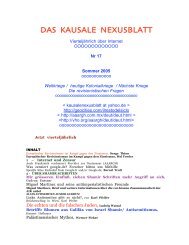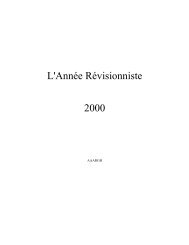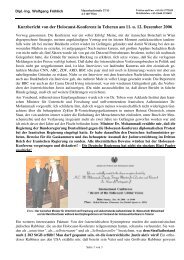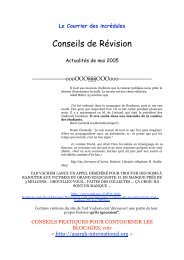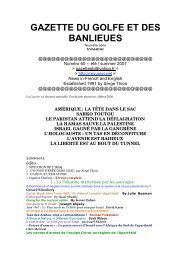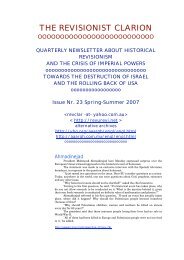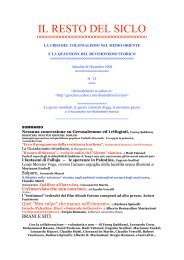hiver - Historical Revisionism by Vrij Historisch Onderzoek
hiver - Historical Revisionism by Vrij Historisch Onderzoek
hiver - Historical Revisionism by Vrij Historisch Onderzoek
Create successful ePaper yourself
Turn your PDF publications into a flip-book with our unique Google optimized e-Paper software.
——————————————————————> Conseils de révisions / <strong>hiver</strong> winter 2007<br />
TEHRAN, Dec. 18 (MNA) -- Robert Faurisson is a revisionist scholar from France who attended the<br />
Review of the Holocaust: Global Vision conference in Tehran from December 11 to 12.<br />
Following is the text of an interview with Faurisson conducted <strong>by</strong> the Tehran Times at the daily’s<br />
offices on December 13:<br />
Q: What is your opinion about the Tehran conference<br />
A: This conference is a big and nice surprise. I had never thought that there could be such a thing. I<br />
was really pessimistic. When for the first time I heard that President Ahmadinejad said that the<br />
Holocaust was a myth, I was so surprised. I wondered if Iran would exist anymore. I thought that the<br />
U.S. or Western countries would try to destroy this country because the belief in the Holocaust is the<br />
central pillar of the West and the world. To say that it is a myth is something extremely dangerous. I,<br />
as a researcher, might say that it is a myth, but for the head of a state it is extremely dangerous. But he<br />
did it.<br />
Can I say something more<br />
I think that the year 2006 will be counted in history as a very important year because a country<br />
called Iran said no to Bush and yes to revisionists. It is marvelous.<br />
Q: Could you elaborate on what you mean <strong>by</strong> the word myth People use the word in a<br />
lot of different ways. Some mean it did not happen at all and some mean that some<br />
aspects of it happened.<br />
A: President Ahmadinejad has used the right word. The alleged Holocaust of the Jews is a myth. That<br />
is a belief maintained <strong>by</strong> credulity or ignorance. It does not mean that the people who believe it are<br />
liars. They are not liars, but they are believers.<br />
Q: You are an expert in text and document analysis. What kind of information did you<br />
find in the documents from World War II that made you doubt some aspects of the<br />
Holocaust<br />
A: My work was the work of a policeman, not the work of a professor. I was told there was a crime, an<br />
enormous crime. So I said I want to see the weapon of the crime, and I want to see the place. I went to<br />
Auschwitz, Dachau, Saxenhausen… and places like that. And I asked a very simple question. I said<br />
show me a gas chamber. They told me there is a fantastic weapon, and I said, OK, show me.<br />
In Auschwitz they said this is a gas chamber. And I looked at it like a policeman. And I said,<br />
sorry, this cannot be a gas chamber, for very simple reasons. Because they said that the Germans used<br />
Zyklon B. Zyklon B is a product invented in 1920 and it is still used today to kill lice. But Zyklon B is<br />
hydrocyanic acid, it is very dangerous. And they say that the Germans would put 2000 Jews in this<br />
place. Two thousand people in this place, it is already impossible.<br />
But anyway, they would put Jews in this place, and then in the roof there were four holes, and<br />
the Germans would go on the roof and would dump pellets of Zyklon B (in the holes) and then the<br />
Jews were dead. They say that a team, a group of Jews, would come in, very gently, eating, smoking,<br />
taking the dead bodies out to the crematoria, to burn them.<br />
And I said, stop, impossible! Impossible because hydrocyanic acid is something which sticks to<br />
the walls, to the roof, to the ground, and it penetrates the same way in the bodies, it goes in the mouth,<br />
everywhere, on the skin. So, first you cannot enter this place even if you switch on the ventilation<br />
because it sticks very strongly. You cannot get rid of it. And you cannot touch the body of someone who<br />
has been killed <strong>by</strong> this gas. You cannot touch it. And remember, they were eating and smoking. Eating<br />
means no gas mask. And smoking is impossible because it is explosive. So as it is told, it is impossible.<br />
I acted like a policeman.<br />
I went to the U.S. to visit a gas chamber. To execute one man, it is horribly complicated, horribly<br />
complicated, because it is too dangerous. If you see a gas chamber in the U.S., to kill one person, first<br />
you see a door in iron fit like this, sealed perfectly, because you don’t want the gas to leak. And then,<br />
when the man is dead, it is extremely dangerous to go inside. So you have special fans, pushing the<br />
poison out, with a very strong vacuum. Then the gas is sent to a kind of tank to neutralize the gas. The<br />
gas which is supposed to be neutralized with sodium ammonia is sent up in a very high chimney.<br />
On the day of the execution, the guards are not allowed to go up to the towers because even this<br />
gas could be very poisonous. And you have to wait something like one hour, and the doctor and two<br />
people with boots, gloves, and gas masks with a special filter, a very strong one, go inside the place and<br />
try to wash the body, and they have to wash it thoroughly. Still the body is dangerous. You have to wait<br />
and wait. On the day of the execution, in spite of all those precautions, the body remains dangerous.<br />
And the day after, you still have the smell. It is fantastic, it is everywhere. To kill one man!<br />
— 192 —



